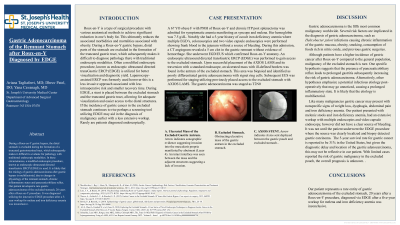Back


Poster Session A - Sunday Afternoon
Category: Stomach
A0708 - Gastric Adenocarcinoma of the Remnant Stomach After Roux-en-Y Diagnosed by EDGE
Sunday, October 23, 2022
5:00 PM – 7:00 PM ET
Location: Crown Ballroom

Has Audio

Ariana R. Tagliaferri, MD
Saint Joseph's University Medical Center
Paterson, NJ
Presenting Author(s)
Award: Presidential Poster Award
Ariana R. Tagliaferri, MD1, Dhruv Patel, DO2, Yana Cavanagh, MD1
1Saint Joseph's University Medical Center, Paterson, NJ; 2St. Joseph's University Medical Center, Paterson, NJ
Introduction: Gastric cancer is the third leading cause of cancer-related death. Although patients have a higher incidence of gastric cancer after Roux-en-Y compared to the general population, malignancy of the excluded stomach is rare. We present a case of gastric adenocarcinoma of the remnant stomach, diagnosed utilizing the EDGE procedure 20 years after Roux-en-Y surgery.
Case Description/Methods: A 67 YO obese F with PMH of Roux-en-Y and chronic ITP post splenectomy was admitted for symptomatic anemia manifesting as syncope and melena. Her hemoglobin was 7.5 g/dL. Notably she had a 5-year history of occult iron deficiency anemia where multiple EGD’s, colonoscopies and two video capsule endoscopies were performed showing frank blood in the jejunum without a source of bleeding. During this admission, a CT angiogram revealed a 5 cm clot in the gastric remnant without evidence of hemorrhage. She underwent EGD/EUS which confirmed Roux-en-Y anatomy. An endoscopic ultrasound directed transGastric ERCP (EDGE) was performed to gain access to the excluded stomach. Upon successful placement of the AXIOS LAMS and its traversion with a standard endoscope, an ulcerated mass with ill-defined borders was found in the antrum of the excluded stomach. This area was biopsied and identified as poorly differentiated gastric adenocarcinoma with signet ring cells. Subsequent EUS was performed for staging utilizing previously placed access to the excluded stomach with AXIOS LAMS. The gastric adenocarcinoma was staged as T2N0.
Discussion: During a Roux-en-Y gastric bypass, the distal stomach is excluded during the formation of a truncated gastrointestinal tract, which subsequently makes it difficult to evaluate for pathology with traditional endoscopic modalities. In these circumstances, a modified endoscopic procedure, known as endoscopic ultrasound directed transGastric ERCP (EDGE) is used. It is likely that the etiology of gastric adenocarcinoma after gastric bypass is multifactorial, due to changes in physiology of the remnant stomach, chronic inflammatory states and pancreaticobiliary reflux. Our patient developed a rare gastric adenocarcinoma of the excluded stomach, 20 years after a Roux-en-Y procedure. It was diagnosed utilizing the innovative EDGE procedure after a 5-year workup for melena and iron deficiency anemia was inconclusive.
Disclosures:
Ariana R. Tagliaferri, MD1, Dhruv Patel, DO2, Yana Cavanagh, MD1. A0708 - Gastric Adenocarcinoma of the Remnant Stomach After Roux-en-Y Diagnosed by EDGE, ACG 2022 Annual Scientific Meeting Abstracts. Charlotte, NC: American College of Gastroenterology.
Ariana R. Tagliaferri, MD1, Dhruv Patel, DO2, Yana Cavanagh, MD1
1Saint Joseph's University Medical Center, Paterson, NJ; 2St. Joseph's University Medical Center, Paterson, NJ
Introduction: Gastric cancer is the third leading cause of cancer-related death. Although patients have a higher incidence of gastric cancer after Roux-en-Y compared to the general population, malignancy of the excluded stomach is rare. We present a case of gastric adenocarcinoma of the remnant stomach, diagnosed utilizing the EDGE procedure 20 years after Roux-en-Y surgery.
Case Description/Methods: A 67 YO obese F with PMH of Roux-en-Y and chronic ITP post splenectomy was admitted for symptomatic anemia manifesting as syncope and melena. Her hemoglobin was 7.5 g/dL. Notably she had a 5-year history of occult iron deficiency anemia where multiple EGD’s, colonoscopies and two video capsule endoscopies were performed showing frank blood in the jejunum without a source of bleeding. During this admission, a CT angiogram revealed a 5 cm clot in the gastric remnant without evidence of hemorrhage. She underwent EGD/EUS which confirmed Roux-en-Y anatomy. An endoscopic ultrasound directed transGastric ERCP (EDGE) was performed to gain access to the excluded stomach. Upon successful placement of the AXIOS LAMS and its traversion with a standard endoscope, an ulcerated mass with ill-defined borders was found in the antrum of the excluded stomach. This area was biopsied and identified as poorly differentiated gastric adenocarcinoma with signet ring cells. Subsequent EUS was performed for staging utilizing previously placed access to the excluded stomach with AXIOS LAMS. The gastric adenocarcinoma was staged as T2N0.
Discussion: During a Roux-en-Y gastric bypass, the distal stomach is excluded during the formation of a truncated gastrointestinal tract, which subsequently makes it difficult to evaluate for pathology with traditional endoscopic modalities. In these circumstances, a modified endoscopic procedure, known as endoscopic ultrasound directed transGastric ERCP (EDGE) is used. It is likely that the etiology of gastric adenocarcinoma after gastric bypass is multifactorial, due to changes in physiology of the remnant stomach, chronic inflammatory states and pancreaticobiliary reflux. Our patient developed a rare gastric adenocarcinoma of the excluded stomach, 20 years after a Roux-en-Y procedure. It was diagnosed utilizing the innovative EDGE procedure after a 5-year workup for melena and iron deficiency anemia was inconclusive.
Disclosures:
Ariana Tagliaferri indicated no relevant financial relationships.
Dhruv Patel indicated no relevant financial relationships.
Yana Cavanagh indicated no relevant financial relationships.
Ariana R. Tagliaferri, MD1, Dhruv Patel, DO2, Yana Cavanagh, MD1. A0708 - Gastric Adenocarcinoma of the Remnant Stomach After Roux-en-Y Diagnosed by EDGE, ACG 2022 Annual Scientific Meeting Abstracts. Charlotte, NC: American College of Gastroenterology.

